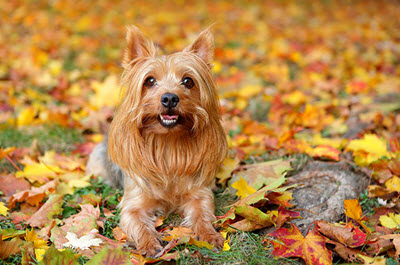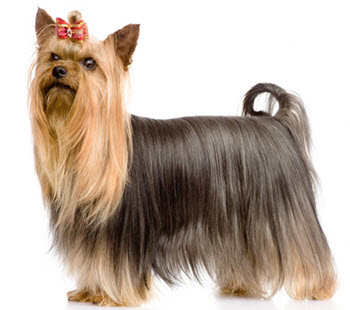Australian Silky Terrier
The Australian Silky Terrier (AST) is a toy breed closely related to the Yorkshire Terrier and the Australian Terrier – the two breeds crossed to form the AST. The Australian Silky Terrier has the temperament of the Australian Terrier and the silky coat and colours of the Yorkshire Terrier.
 True to its terrier origins, the AST is fond of hunting and killing rodent vermin, such as mice. Some also hunt and kill snakes. The UK breed standard stipulates that the dog must look as if has the ability to hunt and kill domestic rodents, but no proof of actual ability is required. (It has been placed in the toy group and not in any of the working dog groups.)
True to its terrier origins, the AST is fond of hunting and killing rodent vermin, such as mice. Some also hunt and kill snakes. The UK breed standard stipulates that the dog must look as if has the ability to hunt and kill domestic rodents, but no proof of actual ability is required. (It has been placed in the toy group and not in any of the working dog groups.)
The long and silky hair is a distinguishing feature of this dog, and various aspects of the coat is extensively described in the breed standard – including desirable shades and exact placement of markings.
Traditionally, the tail of the Australian Silky Terrier has been docked. Today, this practise is illegal in many countries.
Alternative names
- In North America, this breed is referred to simply as Silky Terrier. In Australia, the United Kingdom and many other parts of the world, the name is Australian Silky Terrier.
- One of the pioneers of this breed was McArthur Little. Since this kennel was located in Sidney, the breed was initially known as Sydney Silky or Sydney Silky Terrier.
Short facts about the Australian Silky Terrier
| Breed group (UK Kennel Club) | Toy |
| Size | Small |
| Coat length | Medium |
| Shedding | Yes |
| Grooming requirements | Once a day |
| Exercise requirements | In the lower range |
| Expected life span | 12+ years |
History
Two breeds that both contributed to the creation of the Australian Silky Terrier was the Australian Terrier and the Yorkshire Terrier. The Australian Terrier descends from rough coated terriers brought over to Australia from Great Britain in the 1800s.
The intentional breeding of silky-haired terriers in Australia started towards the late 1800s, when rough coated terriers were crossed with Yorkshire Terriers.
 As mentioned above, McArthur Little in Sydney was a very important breeder in the history of the Australian Silky Terriers. His dogs were known as Sydney Silky Terriers and kept chiefly by households in the city of Sydney. This was during an era were most dogs in Australia were still working dogs, e.g. sheep dogs and guard dogs, and the Sydney Silky was unusual in that it was bred chiefly as a companion dog and a dog suitable for a leisurely city life.
As mentioned above, McArthur Little in Sydney was a very important breeder in the history of the Australian Silky Terriers. His dogs were known as Sydney Silky Terriers and kept chiefly by households in the city of Sydney. This was during an era were most dogs in Australia were still working dogs, e.g. sheep dogs and guard dogs, and the Sydney Silky was unusual in that it was bred chiefly as a companion dog and a dog suitable for a leisurely city life.
Up until the early 1930s, it was common for puppies born in the same litter to be designated Yorkshire terriers, Australian Terriers or Australian Silky Terriers, respectively, simply based on appearance. From 1932 and onwards, crossing these three variants with each other was discouraged. It would however take until 1958 before the Australian Silky Terrier was recognized as a breed by the Australian National Kennel Council and placed in the Toy Group.
Australian Silky Terriers in the United States
The Australian Silky Terrier spread to the USA with servicemen who brought them back with them after being stationed in Australia during or after World War II.
In 1954, newspaper photographs of AST dogs published in the U.S. stirred up an increased interest in the breed among U.S. households, and five years later the breed was recognized by The American Kennel Club under the name Silky Terrier.
Excerpts from the UK Kennel Club’s breed standard for Australian Silky Terrier
| General appearance | Medium length
Compact with refined structure Moderately low-set Sufficient substance to suggest ability to hunt and kill domestic rodents |
| Temperament & Characteristics | Very friendly
Quick Responsive Terrier-like Keen Alert Active |
| Body | Moderately long in proportion to the height of the dog
Chest of moderate depth and breadth |
| Size | Male dogs: 23-26 cm at the withers
Female dogs: Same as the males or slightly less |
| Coat | Straight
Glossy Silky texture Flat Fine 13-15 cm long from behind ears to set-on of tail The coat should not be so long that it impedes the dog’s movements. The coat must be short enough to allow daylight to be seen under the dog. A fine and silky top-knot should be present on the head, but shouldn’t be falling over the eyes. Long fall of hair on the dog’s foreface is undesirable. Straight silky hair parted from nape of neck to root of tail Fine silky top-knot on head, not falling over the eyes Neck well covered with long, silky hair Tail free from long feathering |
| Colour | Shades of blue and tan
Colours should be rich and well defined Lighter blue colours must display dark blue roots Blue on tail should be very dark Black colouring only permissible in puppies |
| Head & Skull | Head strong and of terrier character
Moderately broad between the ears Flat skull |
| Nose | Black |
| Mouth | Strong jaws
Perfect scissor bite Lips tight and clean |
| Eyes | Dark
Oval, never round Relatively small Never prominent Keen and intelligent expression |
| Ears | Small
V-shaped Set high Pricked Entirely free from long hair |
| Feet | Small
Well padded Closely knit toes Black or very dark toenails |
Grooming
The Silky Terrier is only suitable for people who are willing and able to devote a lot of time to care for its coat. Without daily brushing and combing, the coat will become tangled and matted.
It is also important to chose a suitable shampoo; one that can keep the coat clean without causing dryness and skin irritation.
Professional grooming is recommended at least once a month.
The Silky Terrier is prone to teeth and gum problems, and should have its teeth brushed weekly with a toothpaste suitable for dogs.
Health
To reduce the risk of tracheal collapse, many Silky Terrier owners opt for a harness instead of a collar.
